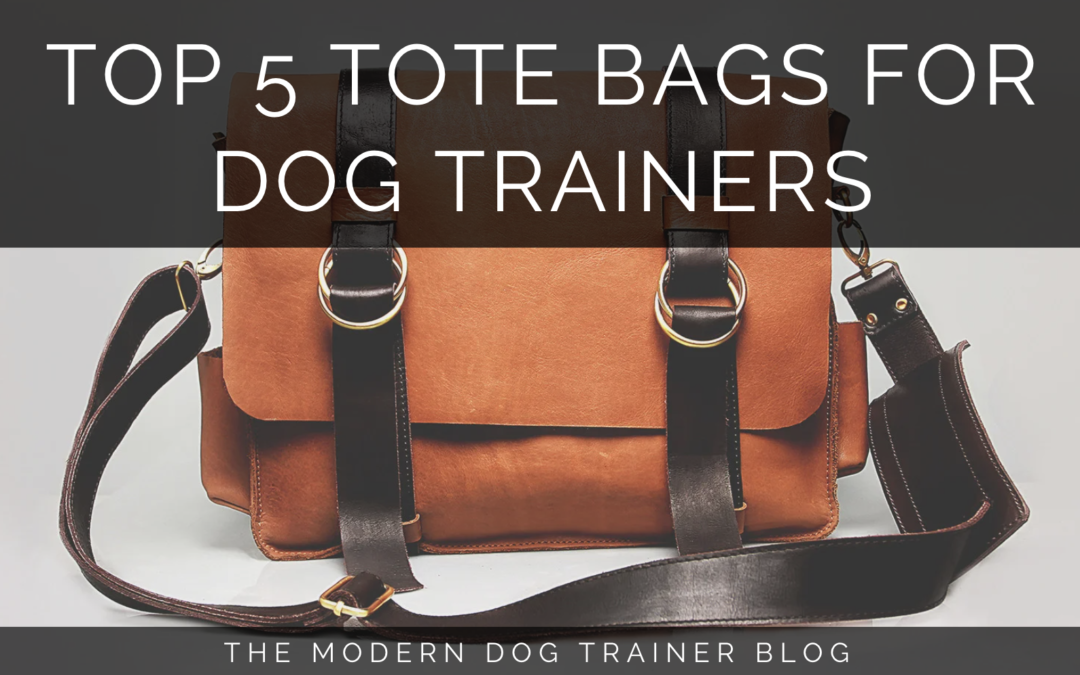
by Laurie Schlossnagle | Jan 30, 2023 | Business
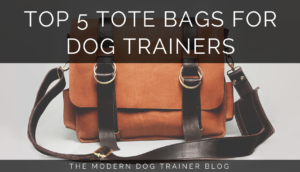 Dog trainers take a lot with them when they are working. Because of this need for “stuff,” dog trainers are always on a quest for the perfect bag to carry it all.
Dog trainers take a lot with them when they are working. Because of this need for “stuff,” dog trainers are always on a quest for the perfect bag to carry it all.
Tote bags are a great way to get organized and to carry all that stuff to appointments and classes. Following is a list of some favorite tote bags of trainers.
Please note – this is not an inclusive list nor is it necessarily an endorsement; these are some bags I personally use and have heard from other trainers they use and like. Additionally, some of the links here are affiliate links, meaning we earn a small commission (at no extra cost to you) if you make a purchase through them, helping us continue offering great advice for your dog training business; we only recommend products we believe in, and we value your trust.
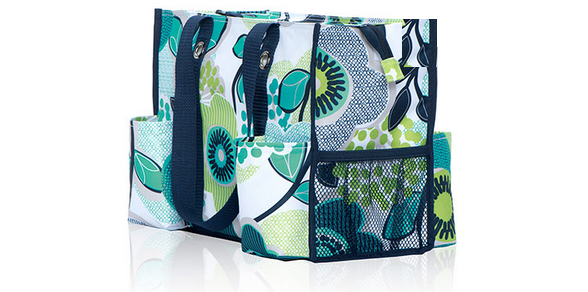
The organizing utility tote from Thirty One is an organized, all-purpose bag with lots of pockets for clickers, receipt books, water bottles, pens, and poop bags. There are two versions of this bag – this one with a zip top and another that is open.
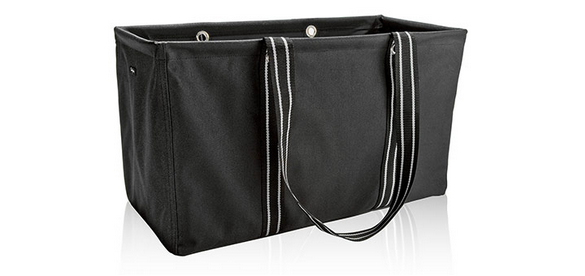
The large utility bag, also from Thirty One, is great for mats, cones, toys, and other big supplies that don’t fit well into other bags. Tops are available for this bag if you prefer a closed bag.
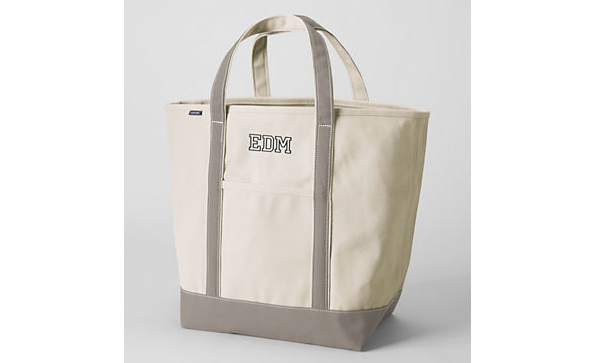
The Lands End bags work well for paperwork – client files, books, contact information, clipboards, etc. They also are good bags for toys. Lands End offers these bags in a variety of sizes, and with or without a zip top.
Products from Thirty One and Lands End are nice because you can get them embroidered with your business name, a monogram, or a paw print. They also come in a variety of colors and prints.


The paw print duffle bag is available from many vendors online. A duffle bag with both handles and a shoulder strap and end pockets and a front pocket is a great bag to have. You can get duffle bags from embroidery businesses with your logo or something dog/business related embroidered on the front pocket. This is can be an all-purpose bag to carry class supplies.


Zippers to keep dogs out might be an important function you will want in a bag. This heavy-duty canvas bag is labeled as a toolbag but can be utilized by trainers to keep all the equipment you might need to carry around from home to home for your training. This bag can carry everything from water bottles to treats and leashes.
What is your favorite tote bag and what do you use it for?
![Four Reasons Why Continuing Education Is Important]()
by Laurie Schlossnagle | Jan 12, 2016 | Business, Training Methods
What Is Continuing Education?
In a quick, unscientific poll of a small number of colleagues and clients, the overwhelming results were that clients appreciate knowing their trainers are participating in hands-on continuing education. To be among the best of the best in the dog training field, it is important to also be a student. Some certifications for dog trainers require continuing education to maintain certification; some dog trainers choose to participate in continuing education.

Continuing education can take on many forms. It can be a book that is read, a dvd that is watched, a seminar that is observed, a local workshop that is hands-on, a national conference that is all of the above with the added bonus of networking with colleagues. While a list of books read and dvds watched can be impressive, spending time and funds on a seminar, workshop, and/or conference shows clients a different level of commitment to continuing education – a level of investment both of time and funds to seek out knowledge and information.
Recommended Reading: Top 10 Dog Training Conferences for 2017
Why Is Continuing Education Important For Dog Trainers?
Accountability – seeking out and participating in continuing education puts a trainer into the position of being a student and demonstrating results.
Commitment – commitment to our profession, commitment to our clients, commitment to our dogs. Attending workshops, seminars, classes, etc. sparks a renewed commitment to spend time doing what we love.
Maintenance of/increasing knowledge and skill – use it or lose it! Teaching helps us to maintain our knowledge and skill but continuing education helps us to increase that knowledge and skill. Learning about new thought processes and methods expands our range of who we can help and how we can help them.
Staying on the cutting edge – there is constantly new science about dogs, about learning, about humans, about the dog/human interaction, etc. Participating in continuing education keeps trainers up to date on the latest and greatest science and how it can be useful in dog training.
Related: Check out our “Mastermind Meetups for Modern Dog Trainers” and request one in your area!
Sign up below to stay up to date with modern dog training business practices and dog training methods!
Dog Training Business Tips
Receive valuable dog training business tips and resources right in your inbox! Subscribe to The Modern Dog Trainer now by submitting your name and email below. Don’t forget to let us know what you want to learn more about!
[mc4wp_form]
by Laurie Schlossnagle | Nov 18, 2015 | Events
It was an honor to be a part of the historic, first-ever Pet Professional Guild Summit in Tampa, Florida, November 11, 12, and 13, 2015. I attended as a presenter (Training and Maintaining Therapy and Crisis Response Dogs) and as an attendee. The Pet Professional Guild provided me with a one-day registration for presenting and provided a Media Pass for the other two days so that I could share information on the Modern Dog Trainer blog.
World Renowned Presenters at the PPG Summit
Pet Professional Guild assembled an impressive group of knowledgeable and skilled force-free animal trainers to share their expertise with other trainers from around the world – Niki Tudge, Dr. Karen Overall, Chirag Patel, Emily Larlham, Pat Miller, Ken McCort, Jacqueline Munera, Dr. Soraya Juarbe Diaz, Pamela Johnson, Mark Hines, Angleica Steinker, Janis Bradley, Theresa McKeon, Laurie Schlossnagle, Diane Garrod, Lisa Morrissey, Shari Sprague, Diana Pappert, Scott Baggett, Nancy Tucker, Linda Michaels, Debra Milliken, Lara Joseph, Maureen Backman, Dr. Michelle Duda, JJ Bachant Brown, and Emily Cassell.
With so many sessions to choose from, it was difficult to decide what to attend. I finally decided to attend:
- Dr. Overall’s keynote session with the opening by Niki Tudge
- Chirag Patel – Shaping the Perfect Patient
- Janis Bradley – That’s the Lab in Him. Breed Bias, a Distraction from the Dog in Front of You
- Diane Garrod – Solving the Aggression Puzzle and Multi-Dog Household Aggression,
- Pamela Johnson – Training Snake Aversion the Force-Free Way,
- Lara Joseph – Online Behavior and Training Consultations and How They are Successful,
- Linda Michaels – Understanding Research: Making the Case for Force-Free Training, and
- Theresa McKeon – TAG Don’t Nag: Techniques to be Force-Free with the Humans in Your Life.
There were also panel discussions on Wednesday and Friday, but I did not attend those (on Wednesday I needed to let my brain rest and on Friday I left to fly home).
For me, two sessions really struck a cord with me – Chirag Patel and Theresa McKeon. In both of those sessions, I learned practical information that I will be integrating into my training, both personally and professionally. They were both excellent, organized, engaging presenters. I will be adding both of them to my list of must-see speakers!
Theresa McKeon’s session was especially wonderful. She created a comfortable atmosphere and allowed personal interactions through which I learned a lot. Overall, the PPG Summit was well organized and the speakers were prepared. Scheduling is a challenge at any conference and can make it difficult to attend every speaker you want to see. The sheer variety of speakers and topics was impressive and valuable.
Most attendees were privileged to session notes before the conference. I missed out on those emails, but Niki Tudge, the Founder of PPG, went above and beyond to make sure I received the notes once I asked about them!
Tampa was a great city to hold the conference. The weather was beautiful and travel was relatively quick and easy. The conference was held in both a hotel and in a convention center which made moving in between sessions time-consuming. Distance played a factor in deciding which sessions I would attend. There were so many interesting speakers and topics to choose from!
Conference Accommodations
The Sheraton Riverwalk Hotel staff had amazing customer service which made my stay very enjoyable. I was able to easily access WiFi in my hotel room and in the conference rooms (at the hotel) which we all know can be difficult to get when traveling!
It looked like there were some very interesting meals to be had in great company, but I was not able to attend them due to a break down in communication. Hotel meals and restaurant meals added up financially, not to mention missing out on stimulating discussions on animal behavior.
Reflections
In the future, I hope to see more vendors attend the PPG Summit. There are a lot of opportunities to meet reputable people in the industry. The effort and planning that goes into an event, let alone a first-ever event, is enormous! Niki Tudge and her team put together a quality educational event for force-free trainers. Trainers came from all over the world to participate and to learn. The 2016 Summit is already being discussed and trainers are looking forward to attending.
It is often said that if you have two dog trainers the only thing they will agree on is that they disagree. The great thing about a conference of dog trainers is that while we still may disagree, we enjoy learning together and being able to be in the same place at the same time with other like-minded trainers. Thank you Pet Professional Guild for offering us this opportunity!!!
Dog Training Business Tips
Receive valuable dog training business tips and resources right in your inbox! Subscribe to The Modern Dog Trainer now by submitting your name and email below. Don’t forget to let us know what you want to learn more about!
[mc4wp_form]
by Laurie Schlossnagle | Nov 14, 2015 | Events
The final day at any conference always has a little bit of a different feel to it; people are ready to go home to their families and pets, eager to put into practice all they have learned, but they are sad to be leaving their friends and colleagues. The 2015 Pet Professional Guild Summit was no different!
My day started with Linda Michaels presenting, “Understanding the Research – Making the Case for Force-Free Training.” She shared what publications are reliable and respected in the field as well as the history of psychology and its importance in animal behavior research.
Linda also shared with us her newly released Hierarchy of Dog Needs™. The new hierarchy is focused on wellness and force-free behavior modification. The complete hierarchy can be found here: http://www.dogpsychologistoncall.com/hierarchy-of-dog-needs-tm/
“There is never a justification to use pain, fear, dominance devices
or training methods with our pet dogs.”
For my late morning/early afternoon sessions, I attended Theresa McKeon’s lecture/lab, “TAG Don’t Nag: Techniques to Be ‘Force-Free’ with the Humans in Your Life.” This was a very interactive lecture/lab and we all had a chance to use TAGteaching to see how well it works in the animal training profession.
Teach without Nagging?
• Arrange goals to be met in steps (shaping)
• Arrange immediate feedback
• Arrange/identify immediate reinforcement
(I spent some time talking with Theresa McKeon after the lecture/lab, saying good-bye to friends, and getting checked out, so I did not attend any other sessions on Day Three.)
Overall, a good three days of continuing education in Tampa, Florida at the first-ever Pet Professional Guild Summit. Thank you to PPG for having me present about Therapy and Crisis Response Dogs and thank you for providing the Media Pass for the other two days at the Summit!!!
See the write ups from day 1 here and day 2 here!
(Coming soon – personal reflections on my experience at the Summit.)
Dog Training Business Tips
Receive valuable dog training business tips and resources right in your inbox! Subscribe to The Modern Dog Trainer now by submitting your name and email below. Don’t forget to let us know what you want to learn more about!
[mc4wp_form]
by Laurie Schlossnagle | Nov 13, 2015 | Events
With no keynote speaker on Day #2, we were able to listen to our choice of presentations for every session. There were five different choices in every time slot.
I started my day with Janis Bradley and her presentation, “That’s the Lab in Him. Breed Bias, a Distraction from the Dog in Front of Us.” In this presentation, she talked about the part genetics plays in behavior for dogs.
During the second time slot, I presented “Training and Maintaining Therapy and Crisis Response Dogs.” It was a small group, so we were able to have a great discussion and we all shared a great deal of information about liability, what skills and training therapy and crisis response dogs should have, and what kinds of exposure.
After lunch, I attended Diane Garrod’s presentation, “Solving the Aggression Puzzle and Multi-Dog Household Fighting.” Unfortunately, the aggression portion of the presentation took up most of the time and there was not much information shared about multi-dog household fighting. The aggression puzzle information was very visual and contained a lot of information.
For my second afternoon session, I went to learn from Pamela Johnson about “Training Snake Aversion the Force-Free Way.” This session was more general in scope because the skills necessary for training a dog to avoid snakes is many of the same behaviors we train in many dogs – for example, recall, leave-it, safe place, and heeling – just with a different emphasis and a particular focus.
At the end of the day, they offered “bite-size lecture sessions.” These sessions are only 30 minutes long. I attended Lara Joseph’s session “On-line Behavior and Training Consultations and How They Are Successful.” In this virtual, online world, this is a great way for trainers to meet the needs of even more clients.
I’m looking forward to Day #3, but my brain is full and I am ready to go home and start implementing some of the new things I have learned.
See Laurie’s thoughts from day 1 of the Pet Professional Guild Summit here!
Dog Training Business Tips
Receive valuable dog training business tips and resources right in your inbox! Subscribe to The Modern Dog Trainer now by submitting your name and email below. Don’t forget to let us know what you want to learn more about!
[mc4wp_form]
![Four Reasons Why Continuing Education Is Important]()
by Laurie Schlossnagle | Nov 12, 2015 | Events
Day one was rich with information!
The Summit opened with PPG President Niki Tudge sharing her vision for the future and thanking those who have helped get both Pet Professional Guild and the Summit itself to this point. “Let the results of force-free training and pet care stand up and be counted.”
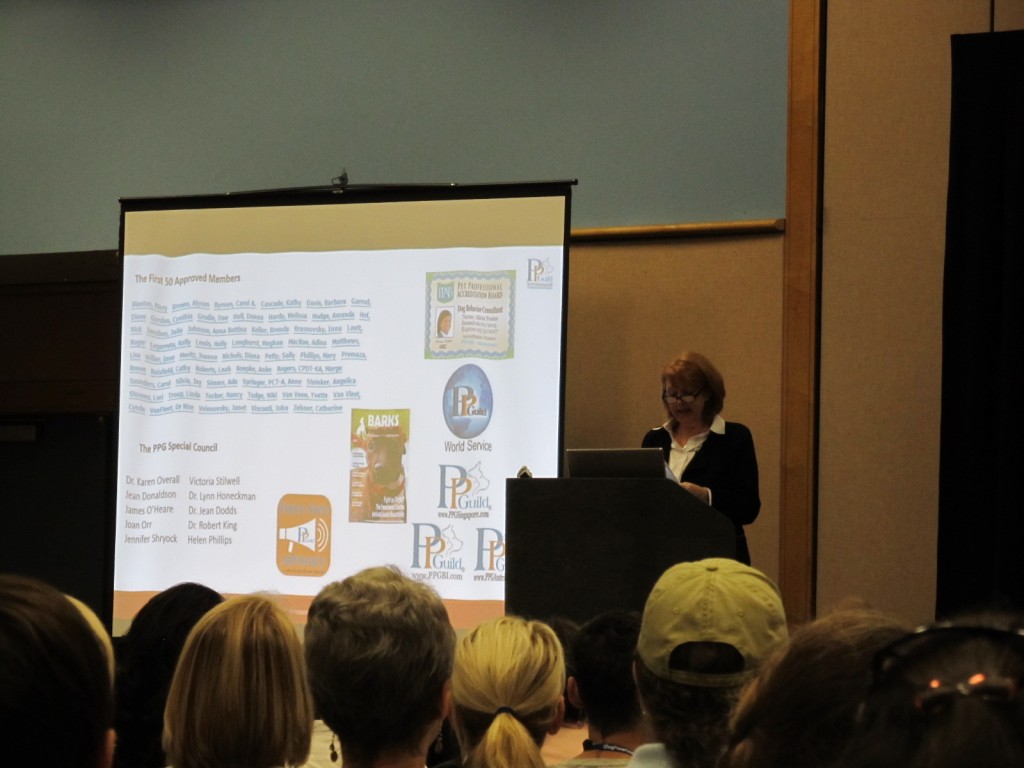
Pet Professional Guild Summit – Keynote Speaker
The Keynote speaker was Dr. Karen Overall. She spoke for the rest of the morning; her presentation was split intofour sections:
From Leashes to Neurons: Humane Behavioral Care for Dogs
1. The brain in evolution and everyday life
2. Neurobiology of reactivity and stress
3. Assessing behavior: what do tests tell us?
4. No fear – redefining humane behavioral care
“Good relationships are not based on fear and restraint. We now have choices. We can do better and understand more. Forward…..”
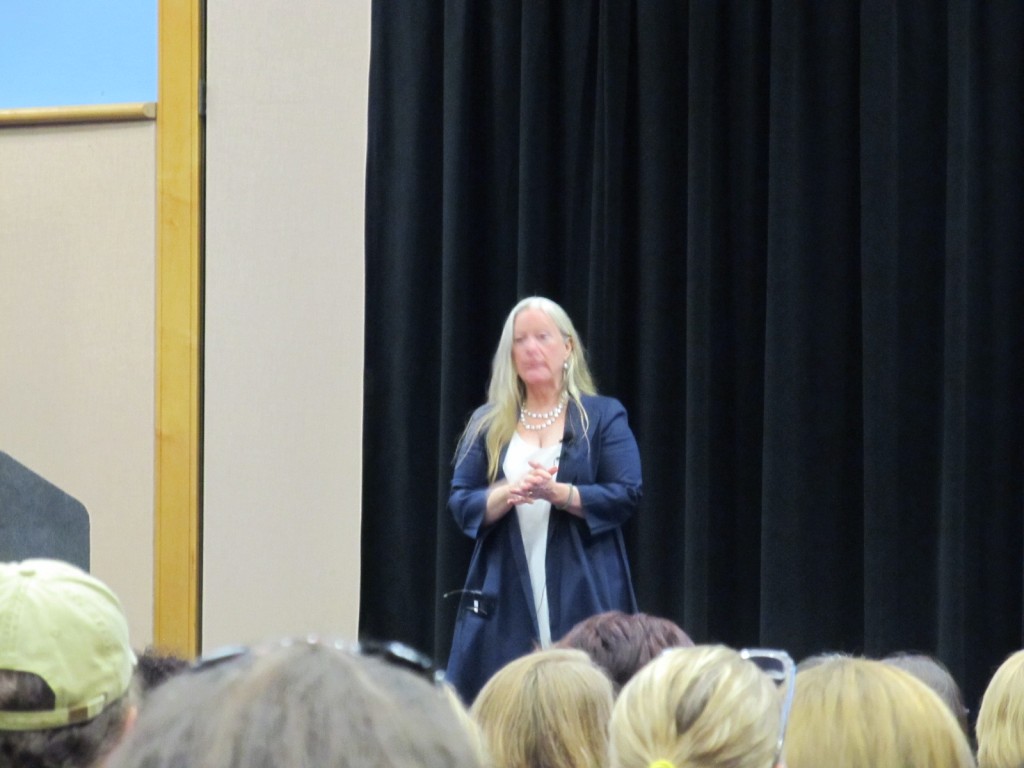
For the afternoon sessions, I attended the lecture and the lab with Chirag Patel: Shaping the Co-Operative Patient. In an interesting metaphor, he said, “Husbandry is my agility.” His lab gave dog/handler teams the opportunity to try out stationing behaviors and The Bucket Game.
“Inspire. Empower. Change.”

Chirag Patel with Laurie and Ashley
Dog Training Business Tips
Receive valuable dog training business tips and resources right in your inbox! Subscribe to The Modern Dog Trainer now by submitting your name and email below. Don’t forget to let us know what you want to learn more about!
[mc4wp_form]
![Four Reasons Why Continuing Education Is Important]()
by Laurie Schlossnagle | Jun 20, 2015 | Events, SPARCS
Utilizing Social Learning In Dog Training
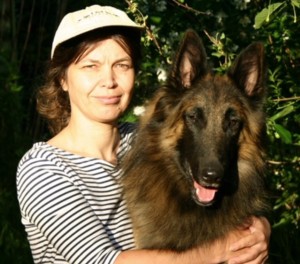 Most people view their dogs as social partners. Evidence indicates dogs view themselves in this way too.
Most people view their dogs as social partners. Evidence indicates dogs view themselves in this way too.
Attachment is a behavior system. Dogs develop an attachment bond to their owners based on dependency and on functionality. Dogs can establish attachment in three short handling sessions and are able to establish successful, new social bonds (for example — puppies raised as guide dogs — first by puppy raisers and then with their owner). Even puppies spontaneously pay attention to humans communicative actions.
Social learning is an effective way to solve problems. In the Detour Test (toy is in full view, but behind a v-shaped fence that dogs can go around to get the toy), dogs who were shown demonstrations on how to get the toy from both humans and other dogs, did significantly better than dogs who figured it out on their own.
Do As I Do
Imitation of human demonstrated actions on command is known as “do as I do.” Dogs appear to have the ability to learn the rules of imitation in a relatively short time. And the generalization of the rules leads to the ability to imitate novel actions. A study by Fugazza and Miklosi in 2014 suggests that DAID is more effective for teaching complex actions.
Model Rival Training
In this form of social learning, the trainer interacts with a model while the dog watches the interaction. The model is a rival because the model gets the social interaction and the dog watching does not (during the modeling time).
Efficiency Of Social Versus Operant Training
Using puppy pairs (approximately 3-4 months old), two tasks were tested. One group was trained to do the simple tasks with operant training (clickers and treats); the other group used social learning to train the tasks. It was found that more puppies learned the tasks in the social group.
Social And Operant Learning Go Hand In Hand
Dogs needed to be trained for a study where they would be getting an MRI. The dogs needed to lay still for eight minutes without any reward — cannot expect food (no drooling allowed), it would be noisy, and they would not be able to see much. There would essentially be no inherent reward for doing this task.
Using both social and operant learning, dogs were taught this behavior. Prior to being in the MRI scanner, 5 — 20 sessions were used to teach a variety of important behaviors using a variety of reinforcers. Then dogs were trained at the scanner in 7 — 11 sessions. The trainers and owners communicated to the dogs via social reinforcers that being on the scanner bed is fun. Model rival training was used several times during this phase. A side note — no time limits were ever incurred on the dogs — they were always allowed as much time as they needed to be comfortable in performing the task. The trainers/owners handled the dogs in a way that they appreciated (worked for) their praise.
In Conclusion
Social learning occurs spontaneously.
Social learning in connection with operant learning is an effective training model.
![Four Reasons Why Continuing Education Is Important]()
by Laurie Schlossnagle | May 27, 2015 | Training Methods
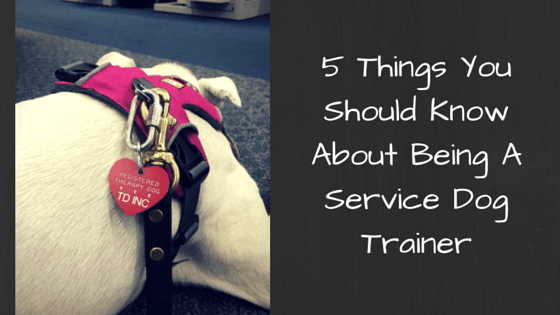
Helping someone train his/her own service dog or training service dogs for their handlers is a time-consuming commitment, but one that is extremely rewarding. This is a time for a trainer to be able to be involved long-term with a dog/handler team with specific goals in mind. Working with service dogs and service dogs in training requires a somewhat unique skill set and body of knowledge. Being a prepared service dog trainer is important.
1. Americans with Disabilities Act (ADA)
Know and understand the Americans with Disabilities Act (ADA). This is the only thing overseeing service dogs at the federal level. Also, know any legislation your particular state may have regarding service dogs and emotional support animals.
2. Document, Document, Document!
Document everything you do. This serves many purposes over time – it can help you troubleshoot, it can help you formulate training plans, it shows the work you have done to ensure a safe, well-trained, appropriate service dog, etc.
3. Be True To Yourself
Know your limits and experience. For example, if you have no experience training an alert dog, refer your client to someone who does. Then ask if you might be able to observe and learn about the training.
4. Research
Do your research. There are no particular certifications or registrations required for service dogs and emotional support animals. Know the difference between service dogs, emotional support animals, and therapy animals. Incorporate evaluations like the Canine Good Citizen and Canine Life and Social Skills evaluations into your clients’ training plans.
5. Public Access
Public Access Training is a vital part of service dog training. Having a service dog or service dog in training in the public eye is under a great deal of scrutiny and observation. Ensure the teams you work with understand this and are committed to excellence in public access. Utilize a public access test to evaluate teams. Look online for test examples such as the Assistance Dogs International Public Access Test.
Your best resource when working with service dogs and service dogs in training is the handler — the person the dog is working for! They are going to be the one living with, and benefiting from, their service dog; talk to them about their ideas for how this is all going to work to work together to a mutually beneficial end result of an awesome, well-trained service dog.
Get Dog Training Business Tips!
Receive valuable dog training business tips and resources every week! Subscribe to The Modern Dog Trainer now by submitting your name and email below.
[mc4wp_form]
![Four Reasons Why Continuing Education Is Important]()
by Laurie Schlossnagle | May 21, 2015 | Training Methods
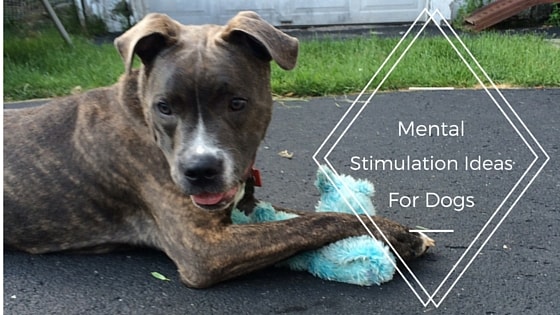
Dogs need both mental and physical exercise to be balanced and healthy. Finding ways to do this can be challenging.
Understanding the need for and providing opportunities for physical exercise is relatively common knowledge among dog owners. But the concept that having a dog or dogs is a partnership and that your dog wants and needs to spend QUALITY time with you, is more difficult. It is not enough to spend time cuddling with them; dogs want to use their brains! They have wonderfully intelligent, creative brains that need to be challenged and stretched to help prevent boredom-related behavior issues. Using some of the ideas listed will not only help dogs’ brains, but will also improve relationships with our dogs.
**Most of these ideas are intended for the owner to be involved or for the owner to supervise the dog. There is a section at the end of things to leave for the dog when s/he is left alone.
Create A Challenging Meal
Feed at least one meal a day in a mentally stimulating and challenging way:
- In a food puzzle (Kyjen puzzles and slo feeders, Kongs and Kong Wobbler, Premier Tug-a-Jug, Barnacle, Squirrel Dude, and Mushroom, Buster Cube, Treat Ball, IQ Ball, Nina Ottosson puzzles) – these are not meant to be left unsupervised with the dog (with the exception of Kongs, Barnacle, Squirrel Dude)
- Throw the food into the yard.
- Put the food in an empty, dry (labels, rings, and caps removed) pop bottles, milk jugs, water bottles.
- Put the food in boxes (see “Toys” section for more information).
- Put the food in a muffin tin (see “Toys” section for more information).
- Use the food in a training session.
- Almost any of the ideas listed below will work to feed a meal.
Games
Get creative and encourage owners to play games with their dogs. Here are a few games that are simple and quick to play every day.
- Hide and seek – with people, toys, and food
- Rapid recalls
- Round Robin recalls
- Tag
- Musical chairs – play music, play with your dog, when the music stops ask your dog to execute a behavior on a mat or a rug, when the music starts again, play again
- What can you do? – get your clicker and treats, ask your dog “what can you do?” start clicking and treating offered behaviors (your dog will probably do SOMETHING to get you to click/treat – use these behaviors to play this game – when we play this, the dogs must offer different behaviors to get the click/treat. Note: this is not a shaping exercise; this is a game.)
- 101 Things to Do With a Box (or a laundry basket)
Toys
Toys come in all shapes and sizes. They are great tools to prevent boredom and enrich a dog’s life.
- Flirt pole (make your own – directions can be found online; I like the Kong version because it’s easy to change out the toy at the end of the line).
- Long line with a grocery sack on the end – your own version of lure coursing (think greyhound racing and chasing the lure). **Don’t let your dog chew on or ingest the bag!**
- Ice sculptures – bowl or bucket or bottom half of a gallon jug – fill with water, toys, treats (carrots and apples work really well!) – freeze – put outside for your dog to play with, interact with, get the toys and treats out of.
- Boxes – start with one box, put some treats or a favorite toy in it, have your dog get the treats/toy out of the box. Progress to nesting boxes with the treats/toy in the innermost box. (This can also be used to feed meals.) Make it more interesting by using peanut butter, spray cheese, or cream cheese in one of the boxes.
- Muffin tin – put treats or kibble in each hole, cover some or all of the holes with tennis balls or crumpled paper. You can also use canned food, rehydrated foods, peanut butter, spray cheese, yogurt, and cream cheese
- Yoga mat – unroll, sprinkle treats, roll back up. Have your dog unroll the mat and get treats.
- Small round basket – put treats or a toy under the upturned basket and have your dog figure out how to get them.
- Perches – phone books covered in duct tape or small, stable stools. Play with different things your dog can do with these. Two paws on (front, back, right, left), four paws on, two paws on move around, etc.
- Hol-ee ball stuffed with fleece strips and small treats or kibble
- Make a “burrito” out of an old towel or blanket, folded up with treats in the folds.
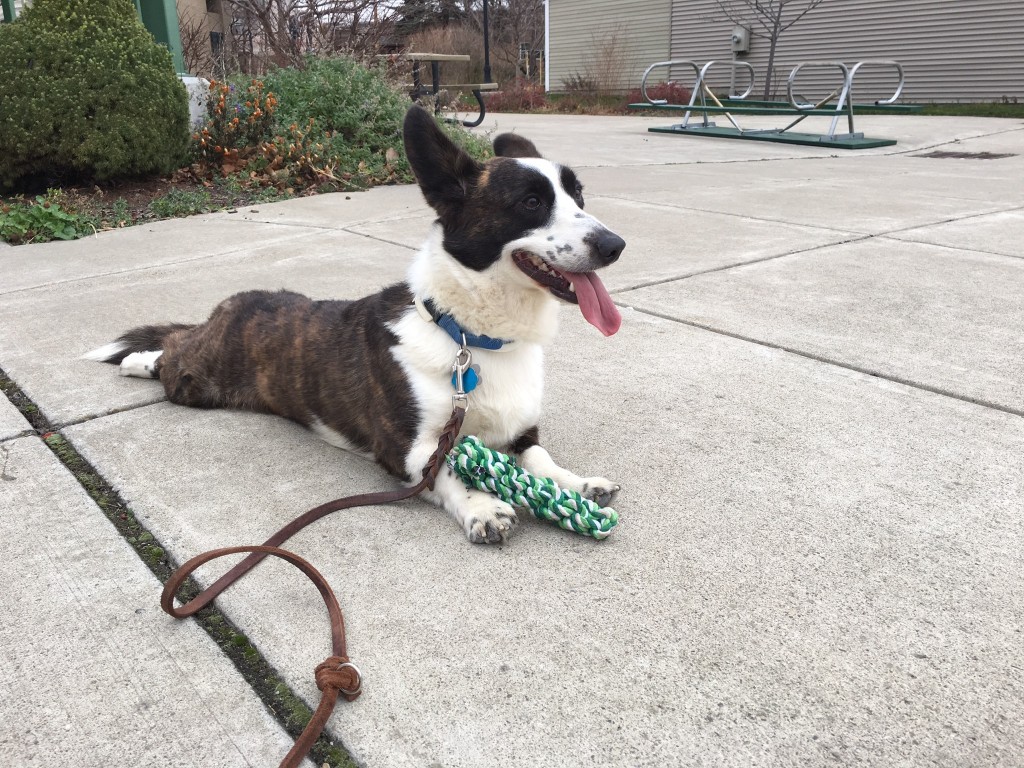 Other Activities
Other Activities
- Take a class – either in person or online – the Fenzi Dog Sports Academy has some great online courses. If you can’t find a class locally or online you are interested in, consider working with a certified, experienced trainer (again, in person or online) to help guide you, answer questions, and help you stay on track. (Scent or nosework classes are a great class for dogs who need to be stimulated/challenged!)
- Join a walking group that takes regular walks with their dogs (I DO NOT recommend off-leash, play group type walks – the walk should be as much about you and your dog as the social aspect for you with the other humans. It should NOT be about the dogs physically socializing.)
- Teach the dog tricks – Do More With Your Dog is a great online program for earning certificates/titles for teaching the dog tricks.
- If the dog likes to dig, create a place him/her to dig – a sandbox, an area of your yard – digging is a natural canine behavior and many dogs reduce stress and get a lot of stimulation when they dig.
Things You Can Leave With The Dog Unsupervised
If it is a multiple dog situation, I only recommend these if each dog is in a crate while you are gone to prevent any issues with resource guarding.
- Stuffed and frozen Kongs, Squirrel Dudes, Barnacles
- Bully sticks – freeze these too so they last longer
- Stuffed and frozen tracheas
- Ears – cow, pig, lamb
Mental stimulation is as important as physical stimulation for dogs. Encourage your clients to plays games and work with their dogs to build their bond and prevent boredom in their dogs.
Get Dog Training Business Tips!
Receive valuable dog training business tips and resources every week! Subscribe to The Modern Dog Trainer now by submitting your name and email below.
[mc4wp_form]
![Four Reasons Why Continuing Education Is Important]()
by Laurie Schlossnagle | Mar 13, 2015 | Training Methods
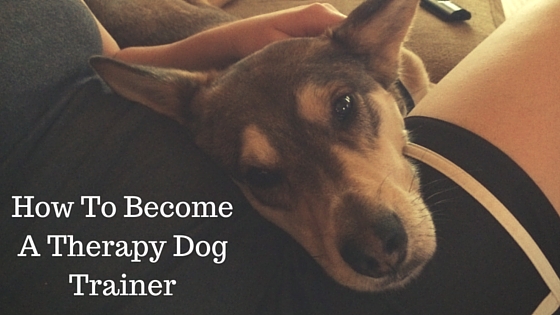
Therapy dogs are a growing population and there is a huge need for trainers and training classes to lead all those new volunteers. These are seven tips to become a therapy dog trainer.
Experience
Therapy dog trainers should have experience working a therapy dog in therapy situations. If your dog is not suitable, borrow a dog. Registered teams do not need to be traditional dog-owner teams; it just needs to be a dog you have a relationship with and will work with you. While you can’t possibly offer your students a full spectrum of experiences, it is important to be able to offer them some. (Therapy dog visits are always new and changing – that’s why it is important for teams to be flexible and accommodating to new situations, environments, people, etc.)
Registering Organizations
Therapy dog trainers should be familiar with the prevalent/popular registering organizations in your area: their insurance policies, their testing requirements, policies and procedures, their equipment requirements, and what is expected and prohibited on visits. Ideally, be a part of at least one of them as a team, as a supporter, or as an evaluator. Being familiar with the organizations and their guidelines will help you know what is required (or prohibited) and will help you determine what and how to teach. (It is important that therapy dog teams are registered and insured with a reputable organization. Many facilities require it. If there is an incident and the team is not registered/insured, it falls to homeowners/rental policies and can be financially devastating.)
Think outside the box!
Therapy dog work is no longer limited to nursing homes and libraries. There are therapy dog teams in a wide variety of locations and situations – hospitals, rehab centers, physical therapy centers, dentist offices, psychologist/psychiatrists’ offices, social workers, schools at all levels and abilities, colleges, various work places, court rooms, depositions, lawyers’ offices, funeral homes, hospices, after school programs, etc. So while a dog and handler may not fit a “traditional” therapy dog mold, they may fit into one of the less traditional therapy dog opportunities available to teams.
A Team Effort
It is important that therapy dog handlers understand that doing therapy dog work is a TEAM effort – both the human and the dog need training and preparation to be their most effective and successful. Challenging the handlers in your classes is important – handlers should be able to appropriately handle different situations in different environments as well as being the best possible handler and advocate for their dogs while visiting.
Be creative in your teaching!
Use lots of different props and equipment. Challenge both the humans and the dogs. Expect and require full participation from teams. Go on field trips. Utilize the information and curriculum available for both the Canine Good Citizen and the Canine Life and Social Skills evaluations. Invite lots of different people to come and help in your therapy dog class. Therapy dog teams cannot be over-prepared.
Foundations
Foundation behaviors are important in therapy dog work. A solid foundation will set teams up for success as well as giving them something to fall back on when a strange, unique, or unexpected situation arises while doing therapy dog work. Heavily reinforce the foundation. Incorporate exercises and games into your curriculum that incorporate foundation behaviors – focus/attention, touch, sit, down, stand, stay, polite leash walking, handling, greetings, and mat work. Distance is not important in a therapy dog class as most registrations require the handler always have their dog on a leash and the leash in the handler’s hand. But duration and distractions are very important!
Support
Ongoing support and training is important for therapy dog teams. Offering teams regular access to a trainer and opportunities to continue and maintain their training is reassuring and encourages teams to continue to train and mature as a team.
Being a therapy dog team is very rewarding; being their instructor/trainer is priceless. Teaching therapy dog teams may take a bit more preparation, but the positive results will far outweigh the investment of time and energy. What is your favorite out-of-the-box teaching tool?
Get Dog Training Business Tips!
Receive valuable dog training business tips and resources every week! Subscribe to The Modern Dog Trainer now by submitting your name and email below.
[mc4wp_form]

 Dog trainers take a lot with them when they are working. Because of this need for “stuff,” dog trainers are always on a quest for the perfect bag to carry it all.
Dog trainers take a lot with them when they are working. Because of this need for “stuff,” dog trainers are always on a quest for the perfect bag to carry it all.









 Most people view their dogs as social partners. Evidence indicates dogs view themselves in this way too.
Most people view their dogs as social partners. Evidence indicates dogs view themselves in this way too.

 Other Activities
Other Activities


